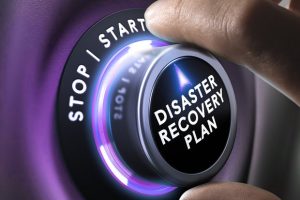 The truth is, mistakes happen. Simple mistakes can lead to costly business disasters, especially when it comes to your business IT. Natural disasters, hardware failures, and human error makes the reality of data loss a matter of when not if.
The truth is, mistakes happen. Simple mistakes can lead to costly business disasters, especially when it comes to your business IT. Natural disasters, hardware failures, and human error makes the reality of data loss a matter of when not if.
It might sound all “doom and gloom,” but having an IT disaster recovery plan in place is essential to ensure that your business can recover from that disaster. Include the following five things in your program.
- Threats and Reactions
Like any good strategy, thinking through every possible outcome is the best way to succeed. This includes your IT Disaster Recovery Plan. Brainstorm the most probable disasters and then solve them. For example, if your business data is infected with ransomware, do you have a backup? Plan for all the steps you need to do to get the infected data out of your system and close the door on that hacker.
- Prioritize Your Systems
Go through your system and data to rate which ones are the most critical and which ones are the least essential for operation. That way, if something happens, you can focus your initial efforts on those items that have the most impact on your profits. Once those are back up and running, you can start working on those less critical functions until you’re entirely online again.
- Put Your People in Place
When a general goes into battle, there is a clear plan of who is completing what tasks. You should have those steps laid out for key employees in your company too. If it is a public issue, who will be speaking on behalf of the organization? If you have a tech department, what is each member working on when the disaster hits? And if you have a company that handles it, do all your employees know to call them when something terrible happens? Ensure everyone knows their role in this situation.
- Practice Makes Perfect
How will people ever remember what they are responsible for unless they practice it? Make sure you do the drills, just like any school dills for emergencies. If you and your staff don’t practice, you will never be prepared to act when a real disaster strikes.
- Update When Needed
This should be a living plan, meaning, it is open to change and adjustment. After you practice, make notes and corrections on what worked and what didn’t work. When your organization grows and changes, your plan should also expand to include everything needed when disaster strikes. Don’t write a plan and forget about it. Adjust for new technologies, new staff, and new situations.
You might think this could never happen to you, but do you want to take that risk? Start making your disaster recovery plan today and be prepared. The best-case scenario would be never to use it. If you don’t know where to start, contact us today. We can consult with you and your team to get a plan in place, and all the tools to help your program succeed!
[x_recent_posts type=”post” count=”3″ offset=”1″ orientation=”horizontal”]


